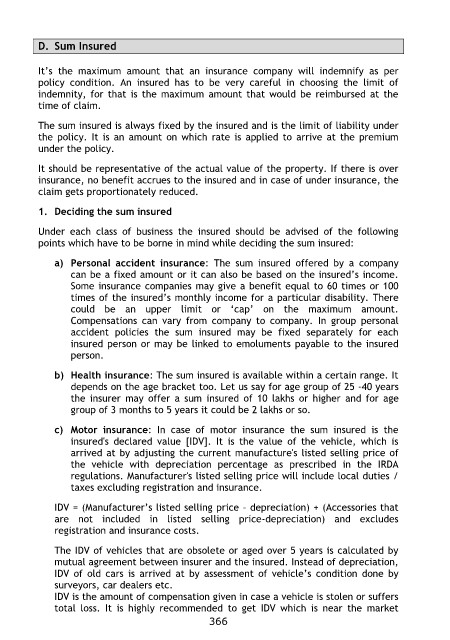Page 372 - IC38 GENERAL INSURANCE
P. 372
D. Sum Insured
It‟s the maximum amount that an insurance company will indemnify as per
policy condition. An insured has to be very careful in choosing the limit of
indemnity, for that is the maximum amount that would be reimbursed at the
time of claim.
The sum insured is always fixed by the insured and is the limit of liability under
the policy. It is an amount on which rate is applied to arrive at the premium
under the policy.
It should be representative of the actual value of the property. If there is over
insurance, no benefit accrues to the insured and in case of under insurance, the
claim gets proportionately reduced.
1. Deciding the sum insured
Under each class of business the insured should be advised of the following
points which have to be borne in mind while deciding the sum insured:
a) Personal accident insurance: The sum insured offered by a company
can be a fixed amount or it can also be based on the insured‟s income.
Some insurance companies may give a benefit equal to 60 times or 100
times of the insured‟s monthly income for a particular disability. There
could be an upper limit or „cap‟ on the maximum amount.
Compensations can vary from company to company. In group personal
accident policies the sum insured may be fixed separately for each
insured person or may be linked to emoluments payable to the insured
person.
b) Health insurance: The sum insured is available within a certain range. It
depends on the age bracket too. Let us say for age group of 25 -40 years
the insurer may offer a sum insured of 10 lakhs or higher and for age
group of 3 months to 5 years it could be 2 lakhs or so.
c) Motor insurance: In case of motor insurance the sum insured is the
insured's declared value [IDV]. It is the value of the vehicle, which is
arrived at by adjusting the current manufacture's listed selling price of
the vehicle with depreciation percentage as prescribed in the IRDA
regulations. Manufacturer's listed selling price will include local duties /
taxes excluding registration and insurance.
IDV = (Manufacturer‟s listed selling price – depreciation) + (Accessories that
are not included in listed selling price-depreciation) and excludes
registration and insurance costs.
The IDV of vehicles that are obsolete or aged over 5 years is calculated by
mutual agreement between insurer and the insured. Instead of depreciation,
IDV of old cars is arrived at by assessment of vehicle‟s condition done by
surveyors, car dealers etc.
IDV is the amount of compensation given in case a vehicle is stolen or suffers
total loss. It is highly recommended to get IDV which is near the market
366

